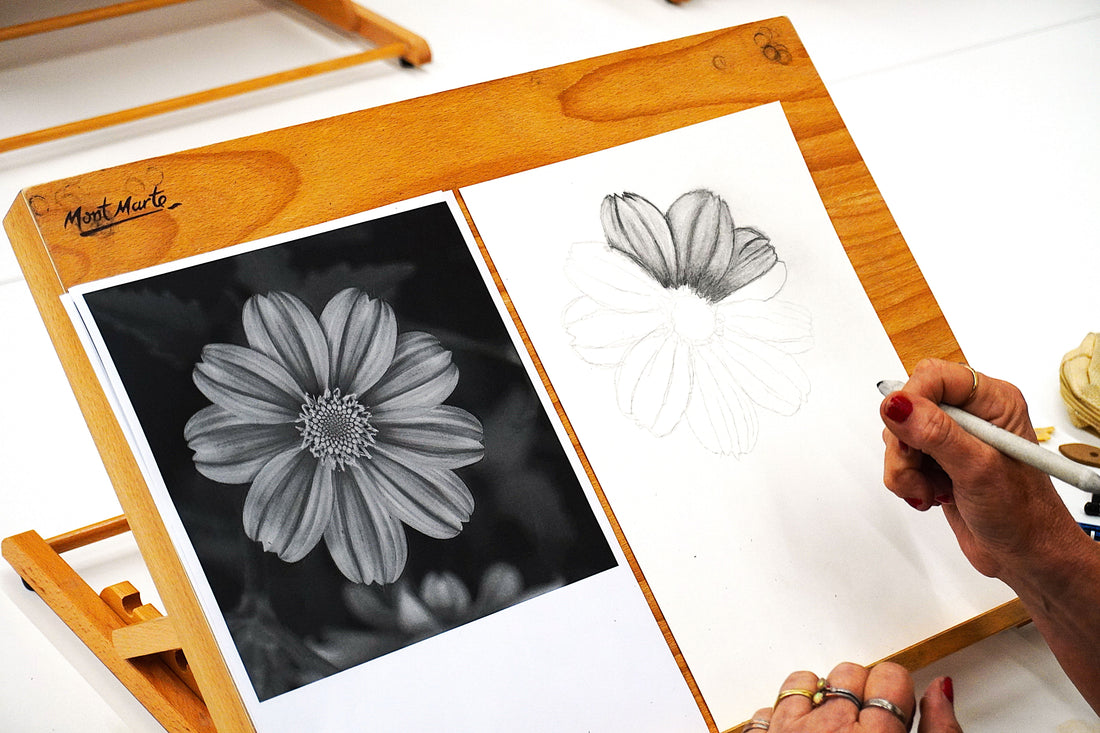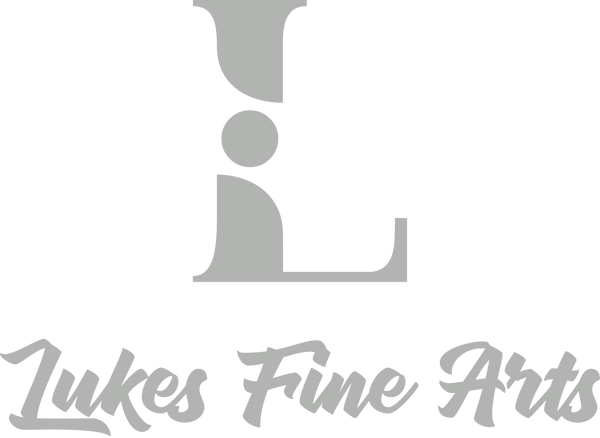
The impact of paper texture on your artwork – what you need to know.
Share
Hey there, artist!
If you’ve ever wondered why your pencil marks feel off or why your shading looks patchy, the answer might not be your skill—it could simply be the paper.
I'm Luke Lewis—artist, art teacher, and founder of Luke’s Fine Arts. Over the years, I’ve helped hundreds of students develop their drawing skills by focusing on the subtle—but powerful—details that make all the difference. And today, I want to share one of the most overlooked tools in your art kit: paper texture.
Let’s pull back the curtain on how the surface you draw on affects your technique, your style, and the very soul of your artwork. Trust me, this small change can open up a whole new world of creative control.
What you’ll learn in this blog
-
What smooth, textured, and rough papers really do—and how they impact your results
-
How smooth paper can help you achieve stunning precision (but why it might hold you back, too)
-
How textured paper brings life, dimension, and beautiful transitions to your drawings
-
When rough paper is your best friend—and when it can become your biggest challenge
-
How graphite behaves on each surface, with clear pros and cons
-
Five of the best drawing papers every artist should try
-
A challenge to help you experience the difference for yourself
Why paper texture matters more than you think
Every pencil mark you make is a conversation between your hand, your pencil, and the paper. And the texture of that paper—also called its “tooth”—determines how that conversation unfolds.
Too smooth, and you might struggle to build contrast.
Too rough, and you’ll wrestle for precision.
Just right, and suddenly everything starts flowing.
Understanding how different papers behave doesn’t just make your art better. It makes creating more enjoyable, more intuitive, and way more expressive.
Smooth, textured, and rough paper – a closer look
🎯 Smooth paper – the precision master
Smooth paper is a favorite for realism and clean detail work. Its surface has very little tooth, meaning your pencil glides effortlessly. Every stroke is sharp, clear, and fully under your control.
But here’s the catch: smooth paper doesn’t hold graphite well. After just a few layers, the surface can become slick and shiny, refusing to accept more graphite. It’s easy to “burnish” the surface too early, leaving you stuck with flat mid-tones and little room to push the contrast.
Why smooth paper helps:
-
It gives you the cleanest lines possible—perfect for tiny details like eyes, hair strands, and clothing folds.
-
It's excellent for blending light layers with a tissue, makeup brush, or stump.
-
Erasers work beautifully on it—ideal for pulling out highlights or correcting mistakes.
-
If you’re a precision-driven artist, this paper gives you the control you crave.
Smooth paper pairs best with harder pencils (H and HB) and light sketching styles, where minimal layering is needed.
🌀 Textured paper – the versatile workhorse
Textured paper has more tooth than smooth but less than rough—making it the best of both worlds. It offers a gentle resistance that catches the graphite just enough to allow for depth, layering, and realism, without losing control.
This is the paper I recommend most for students. It teaches you how to build shadows slowly, control pressure, and get the most out of each pencil grade.
Why textured paper helps:
-
The tooth creates natural variation in tone, allowing you to build light into dark more gradually and beautifully.
-
It holds graphite better than smooth paper—so you can layer multiple passes without the surface collapsing.
-
It adds a subtle grain to your shadows, which gives your drawing warmth and life.
-
Perfect for cross-hatching, shading, or realism with character—where texture is part of the story.
You still need to be careful with blending—too much pressure or rushing can cause patchiness. But once mastered, textured paper becomes a trusted partner.
⚡ Rough paper – the bold statement maker
Rough paper has a heavy, pronounced tooth that produces wild, unpredictable results. This paper isn't for careful detail—it’s for expressive strokes, bold value changes, and raw artistic energy.
Your pencil grabs immediately. Shadows come fast and intense. Every mark is visible, and erasing becomes difficult—but the payoff is a textured, emotionally charged drawing that’s impossible to replicate on smooth paper.
Why rough paper helps:
-
It encourages freedom and looseness—ideal for gesture sketches, figure drawing, or moody illustrations.
-
You can build heavy contrast quickly, perfect for bold chiaroscuro lighting or abstract shading.
-
Rough surfaces allow for mixed media—it plays well with charcoal, pastel, and chalk as well as graphite.
-
It helps break perfectionism and teaches you to let go of overcontrol—a crucial mindset for artistic growth.
It's not ideal for beginners looking to refine realism, but if you're experimenting or looking to push yourself emotionally, rough paper delivers.
How each texture affects graphite and shading (with pros & cons)
🧼 Smooth paper
Smooth paper glides easily under your pencil, offering ultra-clean strokes—but struggles to hold multiple graphite layers.
Pros:
-
Precision and clarity for fine details
-
Excellent for blending subtle tones
-
Perfect for erasing and lifting highlights
Cons:
-
Poor layering ability—can only handle 2–3 passes before becoming shiny
-
Soft pencils (like 6B, 8B) tend to smear or slide
-
Shadows often look flat without deep tonal variation
🪵 Textured paper
Textured paper catches graphite gently, creating rich tone transitions and a balanced drawing surface.
Pros:
-
Great for building layers of graphite
-
Smooth tonal shifts for realistic shadows
-
Adds character and life to your drawings
Cons:
-
Texture can dull sharp edges slightly
-
Blending requires finesse—can look patchy if rushed
-
Takes time to learn pressure control for consistency
🪨 Rough paper
Rough paper embraces texture and tone with boldness. It’s best for confident, expressive work.
Pros:
-
Bold graphite application—dramatic and fast
-
Fantastic for expressive or gestural drawings
-
Excellent texture for mixed media exploration
Cons:
-
Very hard to blend or erase cleanly
-
Fine detail is nearly impossible
-
Eats soft pencils quickly—expect lots of sharpening
🧾 Top 5 papers every artist should try
If you’re ready to experiment, here are five high-quality drawing papers I recommend—each with its own strengths:
-
Arches 300gsm Hot Pressed
Ultra-smooth, professional-grade. Ideal for detailed graphite work and blending, with minimal tooth. -
Canson Mi-Teintes
A beautiful textured paper, perfect for charcoal and graphite. Available in a range of tones for added depth. -
Strathmore 400 Series Drawing Paper
Medium texture, acid-free, and great for layering. A perfect choice for intermediate artists. -
Fabriano Artistico 300gsm Hot Pressed
Comparable to Arches, but slightly softer in texture. Luxurious surface for graphite and ink. -
Derwent Sketching Paper (165gsm)
Affordable, great for student work and practice. Light texture, decent for layering without overkill.
🎨 Your challenge: feel the difference
Want to see how paper texture changes your drawing? Try this:
✏️ Step 1: Choose two different paper types
Select one smooth and one textured or rough paper.
🎨 Step 2: Draw the same subject
On each paper, sketch the same reference image—perhaps a portrait, an eye, or a simple object.
🧠 Step 3: Pay attention
Notice how each surface responds. How does your pencil feel? Do your shadows behave differently? Are your details easier or harder to manage?
📲 Step 4: Share and tag us!
Post your comparison and tag @lukesfinearts. I’d love to see your results and celebrate how you’re evolving as an artist.
🖤 Final thoughts: the power of paper
Paper might seem like a background element, but it’s anything but passive. It's the stage your art performs on, and it shapes the entire experience—both for you and the viewer.
The more you understand how each paper behaves, the more freedom and power you’ll feel at the drawing table.
So take your time. Explore. Experiment. And remember:
The right paper doesn't just support your art—it enhances your voice as an artist.
Thanks so much for reading. Now go make something beautiful.
—
Happy drawing,
Luke Lewis
Artist & Art Teacher
Founder of Luke’s Fine Arts
📍 Perth, Western Australia
📞 0405 268 796
🌐 www.lukesfinearts.com.au
📸 Instagram: @lukesfinearts
